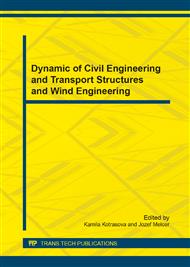p.225
p.229
p.233
p.239
p.243
p.247
p.253
p.257
p.263
The Effect of the Carbon Nanotubes on the Mechanical Fracture Properties of Alkali Activated Slag Mortars
Abstract:
New nanomaterials such as carbon nanotubes and nanofibres considerably improve performance of current building materials and they can contribute to new application facilities. Alkali activated slag is a material having a great potential to be used in practice. The main drawback of this material is a high level of autogenous and especially drying shrinkage, which causes a deterioration of the mechanical fracture properties. The aim of this paper is introduce the effect of carbon nanotubes admixture on the microstucture and mechanical performance of alkali activated slag mortars. The three-point bending tests of specimens with central edge notch were performed. Method of acoustic emission was used during this testing.
Info:
Periodical:
Pages:
243-246
Citation:
Online since:
August 2014
Authors:
Price:
Сopyright:
© 2014 Trans Tech Publications Ltd. All Rights Reserved
Share:
Citation:


